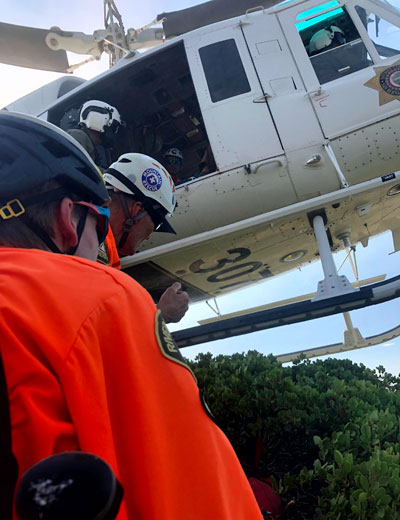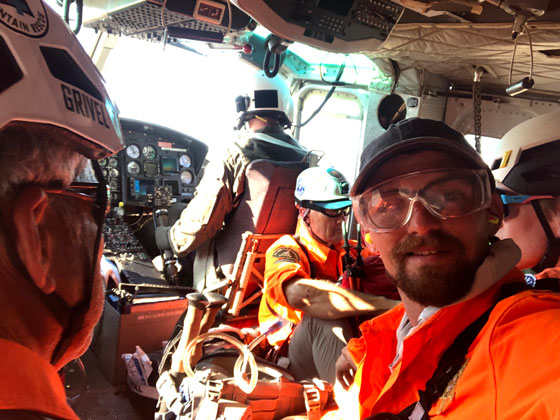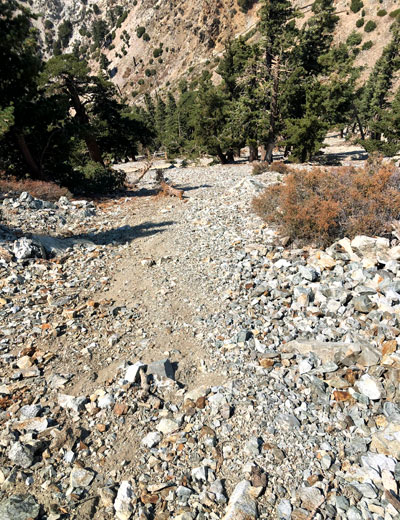Missing Man OES Cucamonga Peak
Sept 6, 7, and 17, 2022
Cucamonga Wilderness Area of the Angeles National Forest
Mission 2022-026
Written by: Richard Yocum and Blake Douglas
Richard:
On 9/5/2022, RMRU was request by Cal OES to assist starting 9/6/2022 in a mutual aid search and rescue operation for Carlos Monay Garcia, a 46-year-old man who on 9/4/2022 was on a day hike with a friend to summit Cucamonga peak. He was last seen when he parted company with his hiking companion on the switchbacks below the peak and above Bighorn Saddle, with limited water and food, and no headlamp, map, compass, GPS, or phone.

On 9/6/2022, along with helicopter and drone aerial searching, numerous field teams from several counties were deployed to search the peaks, trails, canyons, etc. The 5 members of RMRU were inserted by helicopter on Cucamonga Peak and proceeded to their assigned search areas, with James and Tobias searching the very steep slopes below the peak and Steven, Vinay, and Richard searching along the trail between Bighorn Saddle and Icehouse Saddle, and then up to Timber Mountain. Both teams hiked out together down Icehouse Canyon to their motorized extraction point at the trailhead. Neither Carlos nor any definite clues were reported on this day of searching.

Blake:
On 9/7/2022, RMRU was again requested to respond to the OES callout. We deployed myself, Steve Rider and Matt Frenken. We were assigned two adjacent areas on the northwest face of Etiwanda Peak, which is to say, a long talus slope with unknown obstacles. We were told that a prior team had covered the upper half of one search area, but that they were unable to proceed due to needing rope to continue, so we anticipated and packed for rappels.

The upper region of our search area was steep and uneven, but easy to search due to relatively dispersed vegetation, and no large rocks or terrain that would obscure a human. We quickly agreed that the likelihood of our subject being in this area was low due to there being no attractive features (water, shelter) and the terrain being visibly difficult from the trail. Nevertheless, we continued descending in traversing sweeps until we reached a point where the descent split into two shallow gullies with a ridge between them. Matt took the talus gully to the left, Steve took the ridge, and I took the stepwise gully to the right. We all encountered “interesting” terrain but nothing technical or requiring ropes, and we found no signs of our subject, and virtually no signs of human presence at all, which is often an indication that the area is truly avoided.
Upon reaching the base of our lines, we linked up to the Middle Fork Trail and hiked out. Search operations were then suspended for several days due to the storm front from Hurricane Kay making conditions unsafe.
On 9/17/2022, the OES callout was reactivated and RMRU was requested, SBSAR hoping to get in a few more hours of searching before terminating the effort. At this point the searches had been ongoing for at least a week, with hundreds of hours of search time, but no evidence of Garcia had been found whatsoever. Myself, Tyler Shumway, Caleb Milner, Matt Frenken and Tobias Moyneur responded. We were split into two teams, with Tyler, Caleb and Tobias headed to another area near Etiwanda Peak, and Matt and me heading to the switchbacks leading to Cucamonga Peak, one of the high-probability areas and the location of Garcia’s point last seen.
After exiting the helicopter Matt and I discussed how to proceed, since we wanted to cover as much untouched ground as possible but recognizing the value of re-searching parts of this high-probability area. We decided to proceed west, off the end of a small bump at the edge of the summit “plateau”, where we found a backpack that seemed to match the subjects. Our excitement was deflated when we discovered that rather than being gray, like the subject’s pack, ours was originally green, with the exposed portions having faded to gray due to UV exposure. Following this, we descended along our search route, finding trash and signs of alternate use trails, but no signs of Garcia.
SBSAR concluded the search with no evidence of Garcia’s whereabouts.
LESSONS:
Late summer is an attractive hiking season, particularly for recreational hikers who may not venture into true wilderness very often, and search teams observe several factors in common to missions that take place during this time. This mission is reinforced by similar circumstances that took place on a search by Inyo and Sierra Madre SAR near Split Mountain the week before.
• Do not leave people behind, particularly when they are physically struggling, disoriented, or showing signs of exhaustion. Have an experienced member of your team run “sweep” in the rear or stop and take an extended rest. Make a plan for when to abandon your hiking objective and turn around. Leaving people behind should only occur in specific medical and emergency scenarios.
• Bring abundant water and food, a dedicated light source, and your phone.
• Research! Spend at least a day, at least a day ahead of time, reviewing maps and trail reviews of your destination, with a particular mind toward knowing your options. If you get lost at point A, what could help you find your way again? Is your route appropriate for your current skill and fitness level? Have you discussed plans with your hiking partner and family on what to do if you are lost, separated, or running late?
RMRU Members Involved: (James Eckhardt, Matt Frenken, Caleb Milner, Tobias Moyneur, Steven Rider, Tyler Shumway, Vinay Rao, and Richard Yocum)
